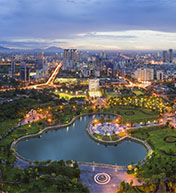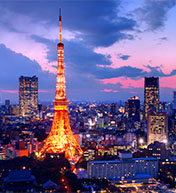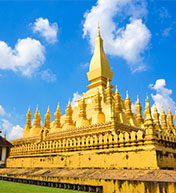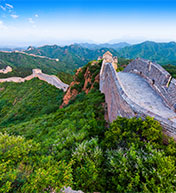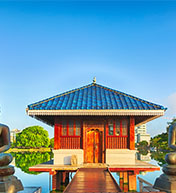立即成为 hutchgo.com 会员!
每个预订最多8位乘客。 每位成人最多可带3位小童及1位婴儿。
备注
每个婴儿乘客必须由一个成人陪同。婴儿于整个旅程中,年龄必须少于2岁。有关婴儿票将不佔座位。 如需预约婴儿篮,请登入后于「修改我的预订」提出申请(视乎航空公司的条款)。 小童于整个旅程中,年龄必须少于12岁。
从 新加坡 (SIN) 出發的 釜山 (PUS) 平价机票优惠
釜山 旅游贴士
Busan, officially Busan Metropolitan City, is South Korea's second largest metropolis after Seoul, with a population of approximately 3.6 million. The population of the metropolitan area, including the adjacent cities of Gimhae and Yangsan, is approximately 4.6 million. It is the largest port city in South Korea and the world's fifth busiest seaport by cargo tonnage. The city is located on the southeastern-most tip of the Korean peninsula. The most densely built up areas of the city are situated in a number of narrow valleys between the Nakdong River and Suyeong River, with mountains separating some of the districts. Administratively, it is designated as a Metropolitan City. The Busan metropolitan area is divided into 15 major administrative districts and a single county.
Busan is Korea’s largest port city filled with endless excitement and pleasant surprises. Busan has Korea's largest beach and longest river, and is home to the world's largest department store, the Shinsegae Centum City. Every year, tens of thousands of visitors from all over the country and around the world flock to Haeundae, Songdo and Gwangalli Beaches to relax or to attend festivals. The city annually hosts the International Fireworks Festival and the Busan International Film Festival, while regularly holding various events at Centrum City, the world’s largest department store. Other must-see tourist sites include Taejongdae Resort overlooking the sea, Yongdusan Park, Yonggungsa Temple on a cliff, and the Jagalchi Market.
Climate and weather
Busan has a humid subtropical climate where you can rarely find extremely high or low temperatures. Late springs and early summers are usually cooler than inland regions because of the ocean effect while it is hot and humid in late summer and early autumn. October and November are generally the most comfortable months with clear skies and pleasant temperatures. Winters are cold and comparatively dry with high winds. However, Busan and the nearby area have the least amount of snow compared to other regions of Korea due to its location. Snow falls on an average of only about 6 days per year.
Transportation
The city has a well-developed public transportation system, but for a more convenient and all-inclusive tour, hop aboard the Busan City Tour. Circulation tour bus tours between Busan station and Haeundae Beach and between Busan station and Taejongdae Resort Park are the most popular route among all. All-day tickets allow visitors to get on and off the bus at any stop, offering an affordable way to visit many attractions in Busan. Tourists are also encouraged to make use of the metro in hopping in and out to different attractions since it is an affordable yet convenient way to travel around the city.
Gourmet
Busan, being a port town, has a cuisine that's strongly focused around seafood, plus starchy snacks and vegetables. The Jagalchi Market is Korea's largest seafood market. This market represents Busan and is famous throughout the country. The Jagalchi Market is where you can get to see the lifestyle of the indigenous Busan natives. One can find good local snacks and traditional cuisines such as mackerel, sea squirts and whale meat on wooden boxes along the road. Other than the well known banana milk, stir fried eel with spice is another must try dish in Busan. Eel is nutritional ingredient and its freshness is another reason to have a try.
Famous attractions
Haeundae Beach is probably the most famous beach in the country. The sand of this beach is composed of sand that comes from Chuncheon Stream and shells that have been naturally eroded by the wind over time. The white sand is rough and sticks easily to your skin. Haeundae Beach is also famous for the various cultural events and festivals held throughout the year. There is also the Beach Culture Center and the Beach Library. Every year from June to August, it welcomes numerous visitors coming from all over the world.
The Busan Aquarium is one of Korea’s top aquariums which contains over 35,000 species of fish, algae, reptiles, and amphibians. The aquarium is spread over 3 underground levels and features an outdoor park. On the first underground level, you can find a souvenir shop and restaurants selling Korean style dishes, while the B2 and B3 levels showcase the various exhibitions. The most amazing and popular part of the Aquarium is the seabed tunnel where you can see various sea creatures swimming right above.
Most temples in Korea are located in the mountains while Haedong Yonggungsa Temple is situated on the coast of the north-eastern part of Busan and built along the shoreline. Haedong Yonggungsa Temple was first built in 1376 by the great Buddhist teacher known as Naong during the Goryeo Dynasty. Other special sites at the temple are the 108 stairs and stone lanterns lining the rocky landscape. After going down the 108 steps, one will be delighted with the beauty of the temple. Midway down the 108 steps one can stop and enjoy the calming sounds of the waves, and view the majestic sunrise.
热门城市目的地 平价机票- 新加坡 (SIN) 往
- 阿尔堡
- 艾恩
- 阿胡斯
- 阿勒泰
- 阿伦镇
- 爱比莲
- 阿尔布克尔克
- 阿巴甸
- 亚布森保
- 亚宝扎
- 阿尔勃里
- 亚尔班尼
- 亚巴甸
- 亚加普尔科
- 阿克拉
- 兰莎努迪
- 蓝德吉
- 瓦科
- 尤里卡
- 兴义
- 亚丹那
- 亚的亚斯贝巴
- 阿德亚曼
- 阿德莱德
- 科迪亚克岛
- 亚力山大
- 阿库雷立
- 亚加狄
- 马拉加
- 奥古斯达
- 阿瓜斯卡连特斯
- 柯希罗
- 阿吐达奇岛
- 雅陶岛
- 大西洋城
- 阿雅卓
- 亚拉加犹
- 旭川
- 奥克兰
- 京修文
- 阿克苏
- 奥玛娣
- 阿尔班尼
- 亚利干的
- 奥他
- 窝得鲁
- 亚力山大
- 维拉维拉
- 亚历山大
- 亚马利罗
- 阿姆达巴达
- 安本
- 阿姆斯特丹
- 安克雷奇
- 安多法加斯他
- 安纳
- 安哥拉
- 安特卫普
- 安提瓜岛
- 安科那
- 青森
- 阿东娜
- 亚罗士打
- 那不纳斯
- 亚皮亚
- 安庆
- 亚里加
- 亚美第
- 窝德镇
- 亚茨加伯
- 爱斯朋
- 奄美大岛
- 亚星斯泉
- 阿斯旺
- 雅典
- 亚特兰大
- 奥他米拉
- 阿姆利则
- 爱浦顿
- 水镇
- 阿鲁巴
- 奥古斯塔
- 阿布扎比
- 奥斯汀
- 厄希维尔
- 维高斯巴尔
- 安瓜拉
- 秋田
- 艾尔斯岩
- 安达利亚
- 卡拉马素
- 碧瑶
- 巴库
- 包鲁
- 包头
- 波玛斯打
- 布班尼斯华
- 巴高路
- 巴塞隆拿
- 百慕达
- 本达堡
- 马辰
- Bandung
- 云多杜亚
- 桥港
- 布林的西
- 巴杜科斯
- 丙顿港
- 贝郎
- 柏林
- 布勒斯特
- 拔科
- 比里福德
- 史曷布夫
- 百加士菲
- 布鲁芳登
- 伯尔法斯特
- 碧咸顿
- 贝尔根
- 班高
- 布兰赫姆
- 巴伊亚布兰喀
- 波保尔
- 破山
- 百克斯
- 伯明翰
- 北海
- 比罗荷里桑得
- 巴斯的亚
- 百雅
- 标灵斯
- 比尔波
- 比亚利兹
- 俾斯麦
- 比美亚
- 雷翁
- 曼谷
- 百可
- 波灵治
- 贝林汉
- 浦勃拉克
- 标伦
- 波伦那
- 邦加罗尔
- 黑水
- 布罗姆
- 潘明顿
- 丙顿岛
- 那士维尔
- 邦莱桑
- 波拉波拉
- 波尔多
- 波西
- 孟买
- 邦拿维
- 波多
- 波士顿
- 巴里八板
- 苏古罗港
- 标蒙
- 昌都
- 亚瓜的拉
- 圣加卢斯地巴维卢芝
- 冰勒
- 不来梅
- 巴里
- 布尔克
- 北灵顿
- 伯尔尼
- 布朗斯维尔
- 布里斯托
- 百克斯岛
- 布鲁赛尔
- 巴罗
- 巴西利亚
- 宝山
- 米卢斯
- 北潭
- Banda Aceh
- 拔期
- 巴顿罗格
- 布拉的斯拉法
- 民都鲁
- 毕灵顿
- 布吉镇
- 布达佩斯
- 布宜诺斯艾利斯
- 巴法罗
- 布加勒斯特
- 本百利
- 宝维斯达
- 巴利维
- 博斯维尔
- 汶莱
- 碧华温拿
- 伯尼
- 波特林
- Butuan
- 加斯加维
- 哥伦布
- 卡利亚利
- 开罗
- 阿格伦
- 卡萨布兰卡
- 高巴
- 剑桥
- Cotabato
- 坎培拉
- 康杜宝连
- 加里吉
- 公塞普森
- 冻湾
- 斯达城
- 克罗伊登
- 科尔多瓦
- 宿雾
- 斯杜拿
- 清唻
- 奥比光城
- 克勒蒙非隆
- 克恩
- 哥芙士港
- 科孚岛
- 居意亚巴
- 常德
- 机华杜角
- 科隆
- 郑州
- 吉大港
- 长春
- 坎普格兰
- 卡牙鄢
- 漆坦诺加
- 基督城
- 芝加哥
- 查洛特维尔
- 查尔斯顿
- 漆咸群岛
- 次高
- 仙达维碧斯
- 赤峰
- 长治
- 高巴陀
- 卡拉马
- 华雷斯城
- 济州
- 格斯毕
- 重庆
- 加拉加斯
- 卡士佰
- 克利夫兰
- 书院站
- 天使港
- 查洛特
- 高他满华
- 地卡文城
- 科伦巴
- 哥伦布
- 湛皮恩
- 肯角
- 高蓝堡
- 克萨哥里
- 哥里安德
- 开恩兹
- 清迈
- 高狄
- 高拿巴维温
- 高澄
- 哥多巴
- 哥罗拉多泉
- 哥伦比亚
- 高巴柏狄
- 哥本哈根
- 哥比亚普
- 甘比那
- 开斯皮尔
- 开普敦
- 哥摩多罗
- Clark (luzon Island)
- 科帕斯克里斯蒂
- 查理斯顿
- 哥伦布
- 赌场
- 圣路易斯奥比斯布
- 卡士达威岛
- 长沙
- 加坦尼亚
- 加达玛加
- 查理维尔
- 科克镇
- 成都
- 古杜
- 古利亚根
- 简勤
- 库拉卡奥
- 智华华
- 古尔
- 高荣顿
- 吉拿维卡
- 维多利亚城
- 库里的巴
- 卡的夫
- 交华
- 圣诞岛
- 加萨斯杜苏
- 查尔德塔斯
- 嘉宜
- 赤云尼
- 高素美
- 古士罗杜苏
- 章州
- 达多那海滩
- 达卡
- 岘港
- 达累斯萨拉姆
- 大同
- 达州
- 杜宝
- 杜布桥
- 杜布罗夫尼克
- 杜比
- 丹东
- 白日梦岛
- 地卡多
- 德里
- 丹佛
- 达拉斯
- 麦芝
- 杜云高
- Dumaguete
- 都闲
- 迪庆
- 的桑
- 第乌
- 底亚巴基属
- 占碑
- 查亚普拉
- 登克岛
- 大连
- 的灵咸
- 杜鲁斯
- 地拉曼
- 大理
- 敦煌
- 登咸
- 登里利群
- 多哈
- 罗奏
- Dipolog
- 德文港
- 大庆
- 德比
- 都温高
- 德累斯顿
- 达尔文
- 得梅因
- 鄂尔多斯
- 多特蒙德
- 底特律
- 都柏林
- 杜尼丁
- 杜保斯
- 德班
- 杜寨尔多夫
- 荷籣港
- 纳卯市
- 杜拜
- Dayong
- 圣塞巴斯蒂安
- 温勒芝
- 艾加利尔
- 厄斯堡
- 伊速加
- 爱丁堡
- 爱德华河
- 依豪芬
- 陀杜拿
- 爱尔卡
- 艾美华
- 厄尔巴索
- 东伦敦港
- 东米兰斯
- 爱麦累
- 肯奈
- 恩施
- 温多华
- 闫安
- 埃斯培兰士
- 普鲁因
- 伊利
- 艾斯加拿巴
- 尤京
- 圣乌斯达特斯
- 依云尼斯
- 埃里温
- 伊凡斯维尔
- 新碧福
- 新伯伦
- 爱克塞特
- 基维斯特
- 非尔班克斯
- 法罗
- 法高
- 法拉斯诺
- 菲日他维尔
- 加力斯贝
- 科特
- 迪法籣西堡
- 弗德里莎芬
- 华朱加堡
- 福岛
- 弗史达夫
- 劳得代尔堡
- 福里安诺普里斯
- 佛罗伦斯
- 佛罗伦斯
- 芬达士岛
- 法明顿
- 慕斯德
- 美亚斯堡
- 丰沙尔
- 哥伦斯堡
- 弗林特
- 福州
- 多芝堡
- 福塔莱萨
- 自由港
- 法兰克福
- 科比施
- 星期五港
- 弗罗路
- 比斯格
- 索斯瀑布
- 静冈
- 博图地努斯
- 阜阳
- 福井
- 福冈
- 维亚雅高
- 惠利堡
- 菲日他维尔
- 山形
- 哥哈娣
- 吉列特
- 官西
- 花院市
- 开曼群岛
- 大峡谷
- 瓜达雅拉
- 但斯克
- 吐克西
- 史朴康
- General Santos
- 哲拉尔敦
- 杰夫
- 大霍士
- 格拉夫顿
- 长景
- 巴哈马
- 直布罗陀
- 吉斯本
- 大曾纯
- 哥罗卡
- 大吉宝岛
- 格拉斯哥
- 格里维尔
- 君茵尼斯
- 吉列士顿
- 格兰诺布尔
- 格林纳达
- 根尼斯维尔
- 热亚那
- 果阿
- 格尔木
- 可德堡
- 高芙
- 海湾港
- 大维柏斯
- 绿湾
- 大岛
- 佐治
- 大维柏斯
- 格拉那特
- 格拉茨
- 温士顿萨林
- 纪亚
- 吉士打维斯
- 格鲁持岛
- 大瀑布
- 哥伦打洛
- 古维努尼路
- 根力逊
- 根尼达
- 古尔本
- 关岛
- 日内亚
- 果亚尼亚
- 占派
- 广元
- 加面安答
- 八丈岛
- 汉诺威
- 海口
- 汉堡
- 长岛
- 哈里斯堡
- 豪格桑
- 哈瓦那
- 荷伯特
- 邯郸
- 侯斯普瑞特
- 合艾
- 希豪
- 黑河
- 赫尔辛基
- 喀黑里昂
- 呼和浩特
- 哈法特
- 合肥
- 享麦非斯
- 杭州
- 希加史顿
- 希根山
- 希尔顿头岛
- 华欣
- 淮安
- 协兵
- 哈华素湖市
- 广岛
- 青州
- 康尼艾华
- 希文岛
- 怀化
- 卡祖华豪
- 函馆
- 香港
- 豪斯建斯
- 布吉
- 克高维
- 海拉尔
- 海伦那
- 哈密尔顿
- 哈密尔顿
- 哈密
- 希罗西罗
- 盛冈
- 荷纳
- 亨前布洛岛
- 檀香山
- 希纳斯
- 荷玛
- 热泉
- 休斯敦
- 哈尔滨
- 虚加达
- 哈灵根
- 佐贺
- 荷斯咸
- Zhoushan
- 亨士威拿
- 哈密尔顿岛
- 和田
- 亨廷顿
- 哈塔伊
- 达维候特
- 华轩
- 花莲
- 华吐高
- 坎巴斯迪
- 赫菲湾
- 康灵士域
- 纽客芬
- 希尔
- 希因内斯
- 海德拉巴
- Taizhou
- 黎平
- 尼加拉瓜大瀑布
- 伊比萨
- 威次塔
- 爱达荷
- 印多尔
- 基辅
- 茵内斯菲
- 布克市
- 伊瓜苏
- 伊哥苏瀑布
- 吉连
- 威尔明顿
- 威尔明顿
- 依努依努
- 维奥
- 伊姆法尔
- 钦柏维斯
- 银川
- 印第安纳波利斯
- 国际大瀑布
- 音斯布鲁克
- 温士顿萨林
- 恩哥
- 恩化尼斯
- 艾安里亚
- 马恩岛
- 艾希士
- 艾山曹
- 威廉士港
- 伊基给
- 洛克河
- 拿维奥加
- 依莎此
- 伊斯兰堡
- 依舒加奇
- 京士顿
- 伊斯坦堡
- 伊他吐巴
- 以夏加
- 希鲁
- 尼威岛
- 英弗卡基耳
- 伊瓦洛
- 岩国
- 文加罗
- 查谟贾木
- 列城
- 奥郎加巴德
- 燕沃勤
- 伊士麦
- 依素母
- 扎比鲁
- 杰克逊
- 捷布
- 积臣
- 杰克逊维尔
- 约阿塞罗
- 景德镇
- 扎西
- 弗里孟特耳
- 嘉峪关
- 吉安
- 柔佛新山
- 西双版纳
- 卡柏劳亚
- 茨特港
- 詹姆士顿
- 潜江市
- 九江
- 晋江
- 庄高平
- 雅加达
- 竹莲
- 米高诺斯岛
- 佳木斯
- 约翰内斯堡
- 济宁
- 朱诺
- 沃也卡他
- 庄维尔
- 祖斯
- 约比稣亚
- 雾斯
- 庄士镇
- 圣达云尼岛
- 祖祖意
- 雅法斯基拉
- 九寨沟
- 江陵
- 卡诺
- 京士陕谷
- 哥踏峇鲁
- 喀比
- 史特奇湾
- 古晋
- 卡赫拉曼马什拉
- 高知
- 肯达
- 基尔
- 京士高地
- 卡尔哥里
- 高斯
- 京加莱
- 喀什
- 高雄
- 卡拉奇
- 南昌
- 克立斯坦斯塔
- 新泻
- 庆伯利
- 京士敦
- 芝斯鲁
- 官简
- 卡利卡利
- 北九州
- 却根尼斯
- 卡利宝
- 克拉根福特
- 基维玛
- 昆明
- 宫崎
- 熊本
- 高麦素
- 金门
- 皇帝岛
- 官老鲁亚
- 佳路亚
- 古邦
- 却克和
- 鹿儿岛
- 赣州
- 浦项
- 金斯
- 金科斯
- 克拉科
- 卡纳
- 克利斯提安散特港
- Kosrae
- 卡茨
- 克利斯提安桑
- 加华法
- 加德满都
- 杰次根
- 加芙莲
- 关丹
- 川路
- 吉隆坡
- 孝那斯
- 库俄比俄
- 官山
- Kwajalein Island
- 贵阳
- 光州
- 桂林
- 屈塔希亚
- 来伊
- 拿菲逸
- 兰城
- Laoag
- 拉巴兹
- 拿威美
- 拉斯维加斯
- 罗顿
- 洛杉机
- 里斯
- 拉伯克
- 勒罗比
- 北皮特
- 莱巴萨
- 纳闽岛
- 拿勒加
- 科伦那
- 查里斯湖
- 朗云拿
- 罗达斯
- 洛豪以岛
- 伊春
- 利亚文夫
- 黎巴嫩
- 哈弗尔
- 阿尔梅利亚
- 来比锡
- 力城顿
- 拿菲逸
- 浮罗交怡
- Legaspi
- 拉哈尔
- 亮光岭
- 兰州
- 利浮岛
- 摩月
- 利豪尔
- 里尔
- 里斯本
- 小岩
- 麗江
- 卢布尔雅那
- 勒尼斯
- 勒克瑙
- 律里亚
- 永州
- 莱斯雾切斯
- 加玛菲瀑布
- 临沧
- 林肯
- 连加士打
- 拉奈市
- 连斯
- 伦敦
- 海旁/普拉亚
- 拉哥斯
- 蒙高华
- 加拿利群岛
- 林利平
- 利物浦
- 纳鹏云达
- Luang Prabang
- 喃邦
- 拉里多
- 琅格列治
- 罗舍尔
- 罗利翁
- 拉斯古斯
- 拉塞兰那
- 拉哥斯
- 朗塞斯顿
- 里士摩尔
- 努根鲁
- 罗威
- 芒市
- 冠那加佳
- 圣路斯
- 卢森堡
- 拉弗敦
- 利威斯堡
- 刘易斯顿
- 拉萨
- 路克索
- 美维娜
- 洛阳
- 连云港
- 连茨堡
- 临沂
- 化莎拿百
- 里昂
- 艾利
- 拿莎路卡顿拿斯
- 柳州
- 泸州
- 里萨岛
- 林芝
- 青内
- 玛华巴
- 马德里
- 麦兰
- 玛郎
- 梅诺卡
- 马祖卢
- 玛他雾罗斯
- 曼彻斯特
- 马瑙斯
- 马耶圭
- 蒙巴萨
- 马里波鲁
- 蒙达高湾
- 西芝罗
- 毛勒宾
- 麦曲
- 马孔
- 马卡帕
- 马士喀特
- 马山市
- 阳光海岸
- 马西约
- 万雅老
- 牡丹江
- 曼德勒
- 马尔巴拉他
- 门多萨
- 美咸
- 米维典
- 孟菲斯
- 棉兰
- 毛勒顿
- 蒙杜拿都
- 墨西哥城
- 米德福特
- 金比亚山
- 玛云格
- 蒙哥马利
- 玛加列河
- 摩根镇
- 玛茨港
- 曼克顿
- 玛利咸
- 迈阿密
- 美黎达
- 绵阳
- 米兰
- 玛连布拉
- 摩息安
- 莫夕亚
- 肯萨斯城
- 米尔窝基
- 麦斯吉港
- 冠那加佳
- 杰克逊
- 美吉夏拉
- 麦其
- 马尔他
- 马里
- 雾灵
- 梦维利亚
- 美利娜
- 蒙鲁
- 马尔摩
- 女满别
- 铁西迪
- 麦勒山
- 宫古岛
- 玛那岛
- 马尼拉
- 摩比尔
- 莫迪士陶
- 摩尔德
- 满巴
- 密洛特
- 莫斯科
- 摩维亚岛
- 木浦
- 蒙德波利尔
- 米都拉
- 摩城
- 马吉特
- 马里巴
- 马赛
- 玛希宝
- 蒙得利
- 摩利
- 米莎华
- 密苏梭斯
- 麦迪逊
- 密苏那
- 明尼阿波尼斯
- 明斯克
- 马斯特里赫特
- 新奥尔良
- 玛维方
- 蒙路斯
- 买彻兰
- 麦那基那
- 米曹
- 蒙得勒
- 慕尼黑
- 谟尔坦
- 玛维安
- 摩斯湖
- 姆旺扎
- 墨西卡利
- 梅县
- 毛胡也
- 松山
- 墨托滩
- 美里
- 澎湖马公
- 马萨特兰
- 拿勒比
- 拿娃高地
- 那格普尔
- 楼杜加
- 南充
- 那不勒斯
- 拿骚
- 纳塔尔
- 奈罗比
- 白山
- 尼斯
- 纽卡素
- 齐齐哈尔
- 尼维斯
- 恩吴
- 宁波
- 名古屋
- 长崎
- 芽庄
- 南京
- 京斯敦
- 拿勒斯佩
- 南宁
- 南洋
- 纽华
- 纽米亚
- Hastings
- 新普利茅斯
- 内关
- 纽奇
- 拿温地拉
- 罗高平
- 诺士文
- 尼尔逊
- 史冠
- 路莎维尔
- 南斯
- 南通
- 诺曼顿
- 诺托
- 纽伦堡
- 拿夫根达斯
- 诺威治
- 纽约市
- 勒根
- 内比都
- U
- 满洲里
- 奥云治
- 杰克逊维尔
- 奥玛鲁
- 奥萨加
- 带广
- 奥立达他
- 敖德萨
- 诺福克
- 加可雷
- 漠河
- 大岛
- 大分
- 冲绳
- 奥克拉荷马城
- 冈山
- 奥耳比西
- 俄马哈
- 鲁微
- 摩灵顿岛
- Noshiro
- 安斯罗
- 黄金海岸
- 高马
- 波尔图
- 奥利布罗
- 诺福克
- 瓦塞斯特
- 科夫
- 奥兰多
- 大阪
- 奥茨高茨
- 奥斯陆
- 奥斯特雷瓦
- 北湾
- 高斯比
- 奥之打
- 奥鲁
- 阿斯图里亚斯
- 奥云斯保路
- 奥士纳
- Ozamis City
- 柏德邦
- 柏都加
- 太子港
- 巴黎
- 巴特拿
- 宝萨维卡
- 柏布拉
- 西棕榈滩
- 巴拉宝杜
- 碧顿
- 邦达地加打
- 派华斯利华斯
- 波特籣
- 槟城
- 柏斯
- 白沙瓦
- 巴拿马
- 派浦斯
- 皮芝
- 柏比籣
- 槟港
- 格里维尔
- 哈尔科特港
- 希兰港
- 新港纽斯
- 费城
- 彭世洛
- 凤凰城
- 波俄利亚
- 堡加达劳
- 皮尔
- 波叠尔
- 匹次堡
- 柏加斯堡
- 柏吉士
- 泊哈拉
- 北根巴鲁
- 帕朗卡拉亚
- 柏斯堡
- 浦利茅兹
- 巨港
- 飘斯顿
- 林肯港
- 开哥斯
- 帕卢
- 伊利沙伯港
- 孟特港
- 帕尔马
- 马略卡
- 棕梠岛
- 巴勒摩
- 北拍马斯顿
- 潘普洛纳
- 金边
- 风佩
- 坤甸
- 浦拿
- 宾沙高那
- 柏祖莲拿
- 阿雷格累港
- 摩勒斯比港
- 波多普拉大港
- 玻利
- 千里达
- 波斯南
- 帕高帕高
- 布莎拜
- Puerto Princesa
- 帕庇第
- 柏斯桥以斯尼
- 麦哥尔港
- 柏斯葛
- 布拉格
- 大安西
- 比萨
- 柏斯高
- 蓬塞
- 彼得堡
- 棕榈泉
- 普萨达
- 玛路路莱莱岛
- 波特兰
- 波耳
- 奥吉士打港
- 宾达加拿
- 蓬塔阿雷纳斯
- 釜山
- 佩文
- 普洛威顿斯顿
- 普罗维丹斯
- 维尔荷港
- 布图维拿他
- 波特籣
- 波尔图山图
- 彼得马利兹堡
- 比加
- 比文士湾
- 尹甸
- 赞达拜内
- 里顿
- 拿鲁买
- 桥维他路
- 拿隆玛
- 拜伦湾
- 华宝
- 马拉喀什
- 里比罗柏利托
- 维碧市
- 拉罗东加岛
- 里约宾高
- 列丁
- 雷丁
- 屈蒙
- 雷利
- 里西菲
- 雷克雅未克
- 徐腊
- 暹粒
- 里斯丹斯
- 维努莎
- 罗克佛特
- 维亚地亚
- 云芝路亚岛
- 加勒哥斯
- 仰光
- 莱茵兰达
- 罗德岛
- 里芝蒙
- 里约热内卢
- 里维顿
- 里加
- 罗克泉
- 巴彦淖尔
- 露马
- 温麦
- 台中
- 温尼比
- 云尼
- 温内
- 勒恩
- 路安露琪
- 罗彻斯脱
- 洛咸敦
- 罗马
- 卡彼陶山
- Koror
- 罗沙里奥
- 卢多努亚
- 路斯维
- 马里
- 路撤斯特
- 沃素
- 鹿特丹
- 罗勒斯岛
- 鲁鲁陶岛
- 罗瓦涅米
- Roxas City
- 莎巴岛
- 萨克拉门托
- 圣达菲
- 圣地牙哥
- 圣保罗
- 圣安东尼奥
- 萨雅那
- 圣达巴巴拉
- 圣巴菲美
- 南班德
- 史登堡泉
- 诗巫
- 索尔斯堡
- 布浩湾
- 学院州
- 圣地亚哥
- 萨尔布吕肯
- 圣地亚哥
- 圣地亚哥爱斯特罗
- 路易斯维尔
- 仙台
- 山打根
- 桑得斯华尔
- 山得尼斯
- 圣多明各
- 桑坦德
- 悉尼
- 雪德兰群岛
- 西雅图
- 首尔
- Mahe
- 圣马丁
- 圣大非
- 三藩市
- 桑德堡
- 斯匹林菲尔特
- 胡志明市
- 斯卡圭
- 上海
- Nakashibetsu
- 渖阳
- 雅沙
- 秦皇岛
- 谢里丹
- 什里夫波特
- 西安
- 西特卡
- 星高顿
- San Jose
- 莱斯加宝斯
- 塞拉热窝
- 圣安哲洛
- 圣周安
- 石家庄
- 圣洁斯
- 希恩
- 帖蓝罗尼岛
- 史杜玛黑尼斯
- 斯料普里
- 萨尔他
- 盐湖城
- 莎华力湖
- 沙莲娜
- 圣路易波多西
- 圣卢西亚
- 圣路易
- 圣达马利亚
- 圣达安娜
- 山朗
- 苏菲亚
- 桑杜
- 南毛利岛
- 艾斯皮维杜山图
- 派克斯
- 南安普敦
- 圣克鲁斯
- 斯匹林菲尔特
- 札幌
- 咸契塔福耳斯
- 斯普利特
- 玉宝珑
- 史达闲
- 莎拉素达
- 萨尔瓦多
- 森艾石奇
- 布伦瑞克
- 山尼斯锺
- 圣路司
- 山他林
- 斯德哥尔摩
- 司徒嘉特
- 圣达鲁沙
- 查洛特
- 基斯坦士特
- 泗水
- 拉默齐亚
- 太阳谷
- 苏亚
- 索斯市
- 圣芬暹特
- 史达温格港
- 史路维亚
- 塞维利亚
- 莎瑚莎瑚
- 汕头
- 新堡
- 史温山
- 斯特拉斯堡
- 莎利
- 圣玛顿
- 斯和那加
- 思茅
- 庄内
- 施拉加斯
- 三亚
- 萨姆松
- 萨尔斯堡
- 史超域岛
- 苏州
- 深圳
- 兹杰辛
- 托巴哥
- 达罗邦
- 大邱
- Tagbilaran
- 坦拿岛
- 高松
- 谭比哥
- 青岛
- 达巴芝拿
- 塔什干
- 布柏
- 他巴天加
- 汤加
- 坦灵溪
- 宝富奇
- 加拿利群岛
- 杜金和
- 腾冲
- 桐艾/哒叻
- 谭雾那
- 铜仁
- 娣斯华岛
- 他鲁怀
- 德菲
- 瓜拉丁加奴
- 通辽
- 杜斯拿高娣维斯
- 德里仙那
- 特罗尔哈丹
- 素可泰
- 地拉那
- 蒂华纳
- 谭巴架佩亚
- 星期四岛
- 班达楠榜
- Chuuk
- 德岛
- 土耳库
- 达拉何西
- 塔林
- 土鲁斯
- 达拉维夫
- 担培累
- 赛伯达斯
- 谭窝夫
- 济南
- 丹吉尔
- 台南
- 安塔那里弗
- 多勒多
- 特皮卡
- 德琅索
- 富山
- 坦帕
- 迪碧
- 托勒昂
- 德隆的英港
- 陶朗加
- 布利斯托
- 杜尼努
- 他维
- 的港
- 查温杜林
- 达维华
- 爱士坦拿
- 对玛岛
- 天津
- 敦士维尔
- 鸟取
- 海龟岛
- 台东
- 图库曼
- 陶尔萨
- 图麦
- 陶皮鲁
- 图森
- 查维斯市
- 贼河瀑布
- 他威尼
- 吐缓巴
- 双子瀑布
- 斗湖
- 得萨根拿
- 黄山
- 太原
- 泰那
- 诺克斯维尔
- 查桑
- 犹伯拉巴
- 宇部
- Ubon Ratchathani
- 哥伦巴斯
- 犹的加
- 奥巴籣地亚
- 乌特化普尔
- 皇后镇
- 高美芝玛
- 奎塔
- 昆西
- 坎佩尔
- 桥云地
- 神户
- 奥兰巴他
- 鸟美亚
- 伍默拉
- Makassar
- 乌鲁亚朋
- 乌鲁木齐
- Surat Thani
- 犹树亚
- 苏梅岛
- 蔚山
- Udon Thani
- 榆林
- 瓦萨
- 云尼武
- 凡湖
- 瓦那
- 域斯比
- 威尼斯
- 茱莱
- 崑仑岛岛
- 维多利亚
- 洞海
- 瓦得索港
- 维达斯
- 委拉克路兹
- 维戈
- 维琪
- 维也纳
- 维沙利亚
- 维多利亚
- 巴伦西亚
- 维多士打
- 维拉港
- 维尔纽斯
- 维华拿斯
- 维顿堡海滩
- 威桥斯
- 弗隆那
- 维拿希毛莎
- 华斯德拉
- 华多利利岛
- 维萨加巴坦
- 瓦约
- 旺阿努伊
- 华盛顿
- 华沙
- 华维克
- 威海
- 伟柏
- 维娃
- 沃加沃加
- 窝吉
- 温加维达
- 温敦
- 维根尼亚
- 旺尼卡
- 稚内
- 窝查
- 威灵顿
- 惠蓝堡
- 文山
- 温逸
- 温州
- 伍伦贡
- 璜加利
- 温祖
- 弗罗兹拉夫
- 维斯达尼
- 乌海
- 武汉
- 武夷山
- 无锡
- 维域
- 西伟朗
- 万州
- 怀阿拉
- 温咸
- 查碧高
- 圣诞岛
- 向阳
- 西昌
- 锡林浩特
- 摩拿高达
- 厦门
- 西宁
- 赫雷斯
- 徐州
- 日谷达
- 修士的玛利
- Yap
- 阿达华皮士吉
- 圣安东尼
- Comeau
- 巴葛维尔
- 坎贝耳河
- 宜宾
- Sablon
- 拿尼武
- 加士杜格
- 郓城县
- 鹿湖
- 戴维斯湾
- 爱蒙顿
- 雅域特
- 阿尔班尼堡
- 伊哥律
- 弗多力顿
- 米子
- 京士顿
- 葛斯尼路斯
- 吉士皮
- 伊利斯得拿美利拿
- 哈密尔顿
- 芝芙里
- 哈里法克斯
- 柏瓜斯皮
- 宜昌
- 伊宁
- 义乌
- 史提芬维尔
- 金露斯
- 也其玛
- 芝莎西比
- 奇路拿
- 麦梅尼堡
- 毛顺尼
- 蒙特里尔
- 拿塔茨君
- 恩士镇
- 延告
- 烟台
- 盐城
- 屋太华
- 阿尔伯特太子城
- 魁北克
- 温沙
- 坎诺拉
- 力芙桥
- 蒙斯顿
- 金莫斯
- 利根那
- 芬达湾
- 君达柏尔
- 君达
- 红湖
- 云坚溪
- 十宾尼
- 史东尼华拔斯
- 圣约翰
- 曼尼托巴
- 多伦多
- 添名士
- 于玛
- 玉树
- Noranda
- 拿朗治
- 维多亚
- 温哥华
- 温尼伯
- 华布茨
- 金布洛
- 萨斯加顿
- 麦迪逊赫
- 圣约翰堡
- 斯奥斯洛克
- 乔治太子城
- 北湾
- 卡加利
- 史密化斯
- 宾迪斯顿
- 查洛特镇
- 维多利亚
- 邱吉尔
- 鹅湾
- 蒙祖利
- 耶洛奈夫
- 萨尼亚
- Iles
- 隡格勒勃
- 华尔的维亚
- 三宝颜
- 昭通
- 萨拉戈萨
- 保云
- 萨卡特卡斯
- 谭母哥
- 葛斯河
- 湛江
- 依斯他巴
- 加士芝节云
- 曼萨尼罗
- 纽文
- 桑给巴尔岛
- 奥索尔诺
- 皇后镇
- 苏黎世
- 珠海
- 遵义
Thank you for subscribing hutchgo.com. Please be sure to check your inbox for our latest news and special offers!
Close和记旅游有限公司 : 国际航空运输协会牌照号码32-3-0512-5,旅行社牌照号码01195,公司注册号码 T01FC6068D
WS-81
和记黄埔公司

